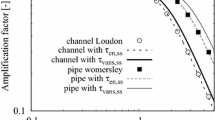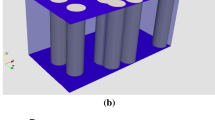Abstract
The equation for the flow of a liquid through a porous medium is either elliptic or parabolic which implies that a disturbance in pressure or head is transmitted with infinite velocity. This is unsatisfactory from a physical viewpoint, although not necessarily from a practical one. If Darcy's law is completed with an inertial term the flow equation becomes a strongly damped wave equation. The proposed additional term can be identified from experiments with confined flow and free surface flow when the pressure or head varies harmonically with time.
Similar content being viewed by others
Abbreviations
- c 0 :
-
characteristic speed
- c 1 :
-
characteristic speed
- c w :
-
characteristic speed
- C :
-
auxiliary parameter
- d :
-
diameter of a bead
- E :
-
modulus of elasticity
- F :
-
auxiliary function
- h :
-
piezometric height
- H :
-
height of groundwater table
- I 0(x):
-
modified Bessel function
- I 1(x):
-
modified Bessel function
- k :
-
permeability
- K :
-
hydraulic conductivity
- L :
-
tube length or channel length
- L 0 :
-
reference length
- m :
-
auxiliary parameter
- n :
-
porosity
- p :
-
pressure
- Q :
-
mass flux
- r=(x, y, z):
-
Cartesian coordinates
- \(\hat r = (\xi ,n,\zeta )\) :
-
dimensionless Cartesian coordinates
- r(p):
-
tube radius
- r 0 :
-
tube radius
- R 0 :
-
tube radius
- r p :
-
equivalent pore radius
- t :
-
time
- \(\bar \upsilon = (u,\upsilon ,w)\) :
-
velocity vector
- V :
-
volume
- α :
-
coefficient of compressibility
- β :
-
coefficient of compressibility
- κ :
-
coefficient of compressibility
- γ :
-
expansibility
- ε :
-
relaxation time
- μ :
-
dynamic viscosity
- ν :
-
Poisson's ratio
- ϱ :
-
density
- τ :
-
dimensionless time
- ω :
-
angular frequency
References
H.C. Brinkmann: A calculation of the viscous force excited by a flowing fluid on a dense swarm of particles. Appl. Sci. Res. A1 (1947) 27–34.
C.S. Yih: Stratified Flows. A.P. (1980).
P.M. Morse and H. Feshback: Methods of Theoretical Physics. McGraw-Hill (1953).
P. Szymanski: Quelque solutions exactes des equations de l'hydrodynamique du fluide visqueux dans le cas d'in tube cylindrique. Journ. de math. pures et appliqueé. Series 9, 11, 67 (1932).
J. Dupit: Études Théoriques et Pratiques sur le Mouvement des Eaux dans les Canaux Découverts et à Travers les Terrains Permeables. Paris (1863).
M.A. Biot: Mechanics of deformation and acoustic propagation in porous media. Journ. of Appl. Phys. 33(4) (1962) 1482–1498.
M.K. Hubbert: Journal of Geol. 48 (1940) 785–944.
J.M.R. De Wiest (ed.): Flow Through Porous Media. A.P. (1969).
R.M. Fand et al.: Resistance to the flow of fluids through simple and complex porous media whose matrices are composed of randomly packed spheres. Journ. of Fluids Engin. 109 (1987) 268–274.
Author information
Authors and Affiliations
Rights and permissions
About this article
Cite this article
Rehbinder, G. Darcyan flow with relaxation effect. Appl. sci. Res. 46, 45–72 (1989). https://doi.org/10.1007/BF00420002
Received:
Revised:
Issue Date:
DOI: https://doi.org/10.1007/BF00420002




